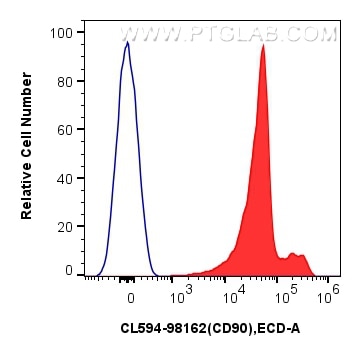Tested Applications
| Positive FC detected in | rat thymocytes |
Recommended dilution
| Application | Dilution |
|---|---|
| Flow Cytometry (FC) | FC : 0.25 ug per 10^6 cells in 100 μl suspension |
| This reagent has been tested for flow cytometric analysis. It is recommended that this reagent should be titrated in each testing system to obtain optimal results. | |
| Sample-dependent, Check data in validation data gallery. | |
Product Information
CL594-98162 targets CD90 in FC applications and shows reactivity with rat samples.
| Tested Reactivity | rat |
| Host / Isotype | Rabbit / IgG |
| Class | Recombinant |
| Type | Antibody |
| Immunogen |
CatNo: Eg1463 Product name: Recombinant Rat CD90/Thy1 protein (His Tag) Source: mammalian cells-derived, pHZ-KIsec-C-6*HIS Tag: C-6*HIS Domain: 20-130 aa of NM_012673.2 Sequence: QRVISLTACLVNQNLRLDCRHENNTNLPIQHEFSLTREKKKHVLSGTLGVPEHTYRSRVNLFSDRFIKVLTLANFTTKDEGDYMCELRVSGQNPTSSNKTINVIRDKLVKC Predict reactive species |
| Full Name | Thy-1 cell surface antigen |
| Calculated Molecular Weight | 18 kDa |
| GenBank Accession Number | NM_012673.2 |
| Gene Symbol | Thy1 |
| Gene ID (NCBI) | 24832 |
| Conjugate | CoraLite®594 Fluorescent Dye |
| Excitation/Emission Maxima Wavelengths | 588 nm / 604 nm |
| Form | Liquid |
| Purification Method | Protein A purification |
| UNIPROT ID | P01830 |
| Storage Buffer | PBS with 0.09% sodium azide, pH 7.3. |
| Storage Conditions | Store at 2-8°C. Avoid exposure to light. Stable for one year after shipment. |
Background Information
CD90 (Thy-1) is a 25 kDa, GPI-linked membrane glycoprotein that belongs to immunoglobulin superfamily (PMID: 6177036; 6153212). Originally described as a brain thymus cross-reactive antigen, it is found in large quantities on mouse and rat thymocytes and central nervous system cells (PMID: 83175). CD90 has been postulated to be involved in cellular recognition, adherence, and T cell activation (PMID: 7683034).
Protocols
| Product Specific Protocols | |
|---|---|
| FC protocol for CL594 CD90 antibody CL594-98162 | Download protocol |
| Standard Protocols | |
|---|---|
| Click here to view our Standard Protocols |




